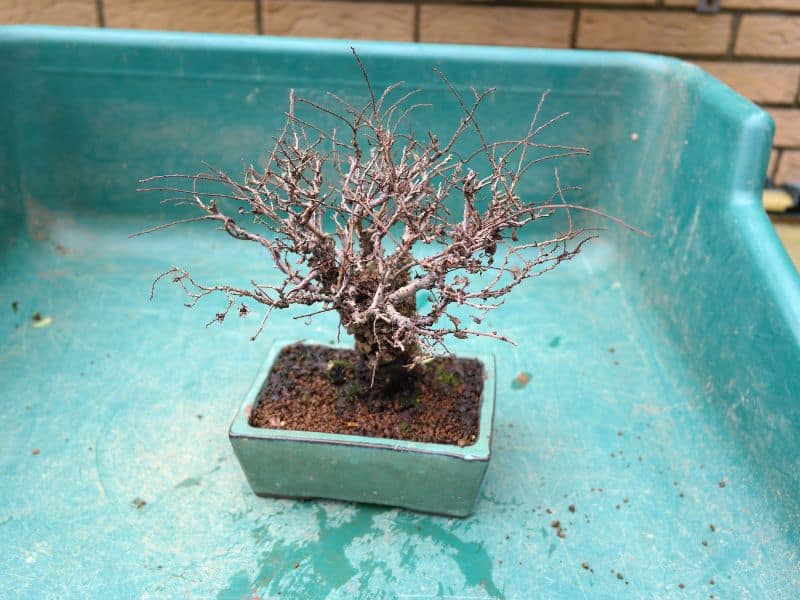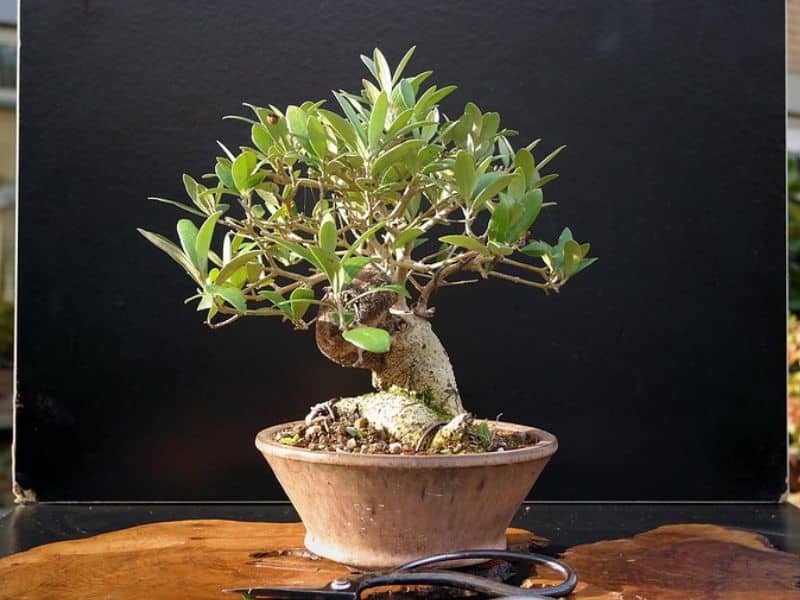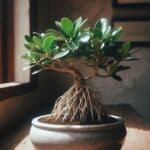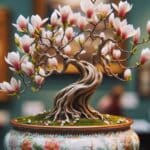Bonsai trees typically don’t die of old age. Most tree species can live much longer than the average human being and can be a life companion. The oldest bonsai tree currently living is a ficus bonsai that is over a thousand years old, and many gorgeous and flourishing trees have been awing the world for over 500 years.
If your bonsai tree does happen to die or is dying, it is most likely that you made some mistake with your care regime.
Bonsai trees require much care and maintenance to keep them in good health. It can be pretty challenging to see if a tree is dying or to tell if it is dead, especially if you have a deciduous tree species.
Deciduous trees tend to shed all their leaves and undergo a dormancy stage during winter, during which the tree may appear completely dead.
So, how do you tell when a bonsai tree is dormant, dying, or dead? And how do you revive your tree if you notice that it is busy dying? Let’s take a closer look.
Common Mistakes in Bonsai Care That Can Make a Tree Die
If your bonsai tree is sick or dying, you might be doing something wrong while caring for it. To avoid further damage to a bonsai tree, it is essential first to identify the mistake you might be making. Here is a quick look at common mistakes bonsai growers often make while caring for these delicate trees.
Forgetting to Water
Plants in small pots need to be watered a lot more often than the plant species you have growing in the ground or larger containers. If the soil dries out completely, the roots of your tree might also become too dry and brittle, and the root ball could also become dehydrated. If the tree is too dry, it will usually show some signs. The foliage might become droopy, or it will start to lose leaves. For evergreen trees, the leaves will start to turn yellow.
If the roots of a bonsai tree have dried out completely, then you can do nothing to revive the plant.
It is important to stick to a healthy watering schedule. Watering might depend on the type of bonsai species you have. Some trees prefer moist soil, while others prefer dryer conditions. It is important to discover your plant species to learn more about its watering needs.
Over Watering
Underwatering can also be very damaging to a small tree. If a bonsai tree is watered too often or if the soil stays moist, it can develop root rot or a fungal infection can cause the roots to die.
Overwatering can occur if you are watering it too often or if the soil mixture isn’t suitable for the species. A soil mixture that doesn’t drain properly or that retains too much moisture can result in root rot.
Insufficient Light
This is a common mistake for indoor bonsai. If your indoor tree doesn’t get enough direct sunlight or indirect light, it might not be able to develop well. The leaves will become sickly and yellow and will eventually fall and your tree will slowly die.
Incorrect Placement
Some bonsai plants are outdoor bonsai, and some are indoor species. Junipers, for example, are common bonsai species and should be grown outdoors. If this outdoor bonsai is kept indoors, its foliage will become yellow, and the tree will slowly die.
On the other hand, indoor bonsai might not be able to handle the extremely hot or cold weather outside or be too sensitive to direct sunlight. Too much light can cause the leaves to scorch, or the tree can dry out too quickly. If so, the tree can die within a few days.
An indoor bonsai should also be placed strategically so it will be protected from the air conditioning unit and still get enough light to stay healthy.
Too Little Patience
Bonsai beginners are often too enthusiastic about growing their trees and end up over-pruning the tree, repotting it too often, or they could adjust the wiring too often. These disturbances can cause a tree to lose a lot of energy and can cause damage to the tree.
Pests and Diseases
Some bonsai species are quite vulnerable to pests and diseases. If your tree becomes infested with pests like spider mites, and aphids or develops a fungal infection, it can become damaged to a point where the tree can start dying.
Unsuitable Container
Bonsai trees need to be planted in a container with many drainage holes. Without drainage holes, the tree roots will start to rot.
The container design can also affect the growth of the tree. Species with a flat root system can grow well in traditional broad and flattened containers. Those with deeper and more vertical roots will require a deeper container.
The container should also be large enough to support the root system and size of the small tree.
Unsuitable Soil
To grow healthy trees, you should use a suitable bonsai soil mixture. Most bonsai trees prefer a soil mixture of equal parts of Akadama, Pumice, Lava Rock, and organic potting compost. Tropical species might also prefer more moisture-retaining soil while succulents and drought-tolerant species prefer poor soil conditions.
Lack of Nutrients
These small trees need to be repotted every one to five years because they can deplete the soil from nutrients and the roots might become too vigorous for the container. If the nutrients are depleted or if there isn’t enough room for all of the roots, the bonsai will start dying.
How to Tell if a Bonsai Tree is Dying
Deciduous trees become dormant during the winter and can appear dead since they will have no foliage or new growth. It can be tricky to see when one of these trees is naturally dormant, shedding its leaves for winter, or if they are dying. The best way to tell if your tree is dying is by keeping an eye out for the following warning signs.

Yellowing or Falling Leaves
You know you have a problem if the leaves of an evergreen tree start turning yellow or start falling. For deciduous trees, this can be very natural during autumn or winter. Falling leaves during spring or summer are, however, a sign of a dying bonsai.
Dead Branches
The branches of a bonsai tree should be soft and slightly bendable. If the brittle branches die and are easy to snap off, your tree will likely die.
Dead Roots
When a bonsai tree dies, its roots will start to dry out, rot, or die. You can carefully remove the tree from the pot to inspect the root system. If the roots are completely dry then the bonsai tree is dead. If there are a lot of dead and healthy roots then your tree might be saved.
Visible Pests
Visible pests on the foliage or roots can also signify that the tree might be dying. Pests and diseases will keep causing damage if they are not cleared from the tree. If you notice any pests or fungus on your tree, treat it with a pesticide or anti-fungal spray as quickly as possible.
How to Tell if a Bonsai Tree is Completely Dead?
Is your bonsai tree dead? Before you discard a damaged bonsai tree, you should carefully inspect it. Here are the top signs that your tree might be completely dead:
- The foliage is yellow, brown, or completely missing.
- Any leftover foliage is crispy or dry.
- The tree has no new growth.
- Fresh buds have turned black.
- The tree isn’t using water anymore.
- The roots are dry and dead or blackened.
A simple scratch test can also be done to check if the tree is still alive. Use your fingernail and scratch the base of the trunk. If the wound is still moist or green then the tree is still alive. You can also scratch the root system and keep moving down the roots to test if the tree is still worth saving.
Can you Revive a Dead Bonsai Tree?
Once the root system has shriveled up, you can never revive it. A tree with many dead branches and even a partially dead trunk can sometimes be revived. There will always be hope as long as the roots are still in good shape.
Tips for Rescuing a Dying Tree

Is your bonsai tree dying? To save your dying bonsai tree, you must first identify its species and the root cause of damage.
It is essential to identify the tree correctly to amend your care routine to something that suits the species better. You should also identify the cause of damage to your tree so you can correct this issue.
If the tree is planted in a poor container, in poor soil, or doesn’t have enough drainage, then you should repot it in more suitable conditions. A tree that is kept in an incorrect position should be moved to a more suitable environment. Any diseases or pests on the tree should also be treated to avoid further damage.
Next, you will need to boost your small tree with some organic slow-release fertilizer. This can give the little tree more energy to recover quickly. Finally, you will need to carefully water your tree at the right intervals so it can develop some healthy new roots.
Conclusion
Keeping a bonsai tree alive and healthy requires a long-term plan. Sticking to a strict care schedule for these types of trees can be difficult, but the right care is critical for avoiding tree death.
We hope that our guide made it possible for you to see if you could still revive your damaged tree or if you should start looking for a new bonsai. We also hope that this guide saves any bonsai trees that might be dying so you can enjoy your little leafy companion for many more years.
Thank you for reading our guide, and we wish you all the best while trying to care for a little tree that might not seem too healthy.
Up next: Can You Bonsai Any Tree?







